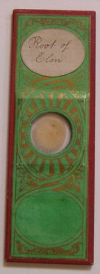edited by Johannes Grave 11:52 - Monday, 23. April 2007
Framing the microscope ‘window’
Why should we frame microscope slides? Scientists of the 19th century may have raised this question, when they came across decorative microscope slides, such as those preserved in the collections of the Whipple Museum of the History of Science in Cambridge. Probably, these slides were produced for interested amateurs and served to popularize science.
But possible economic and cultural motives of this practice of framing slides should not prevent us from having a closer look at one example, which contains a slice of the root of an elm. The ornamental frame of this botanical object contributes by no means to the original function of the slide. Put under the microscope, the decorative frame of the slide is irrelevant; it disappears. But in addition to this usual scientific view of the slide, the ornamental frame opens a second way of perceiving it. When the frame attracts our attention, we look at it without using the microscope. While the usual view through the lenses of the microscope constitutes a framed ‘image’ of a little part of the object, the ornamental frame makes the slide of the root appear as an integral whole.
But, this way, not only the perception of the root changes its character; the neutral glass sheet, we usually ignore, becomes a window that is framed and opens a view beyond its borders. Thus, the frame, which at first glance only seemed to be a neglectable decorative feature, causes an interference of two different, in some ways contradictory, modes of visual perception: the one optically mediated, only concentrated on the botanical object, the other directly perceptible, constituting a window by framing a glass sheet. In this context, the term ‘object’ is characterized by a fundamental ambivalence. It can mean the botanical object, the root of the elm, but can also be related to the slide itself.
Just for one moment, we should have a look at this window, instead of a view through the glass sheet. Only a frame allows a simple sheet of glass to be turned into a window. The window, however, is strongly connected with a fundamental concept of representation in early modern culture. Especially since Leon Battista Alberti called the picture an “aperta finestra†(De pictura I, 19), images were widely understood as windows that open views of a world behind or beyond the surface of the picture.
The microscope slide can be taken for a hybrid descendant of this tradition of pictorial representation. It presents an object in the framework of a window, but is not limited to the classical view through a window, since this mode of visual perception cannot open the differenciated and detailed insights, which make the microscope so attractive and valuable. So, the less old concept of getting insights in previously hidden microscopic structures of objects is struggling with the older ideal of immediate visual perception, which is directly related to the metaphor of the picture as “aperta finestraâ€. The ornamental frame, which at first glance stresses the transparency of the ‘window’, finally distracts our attention from the view through it, prompts us to have a look at the glass sheet itself and makes the microscope slide to some extent opaque.



